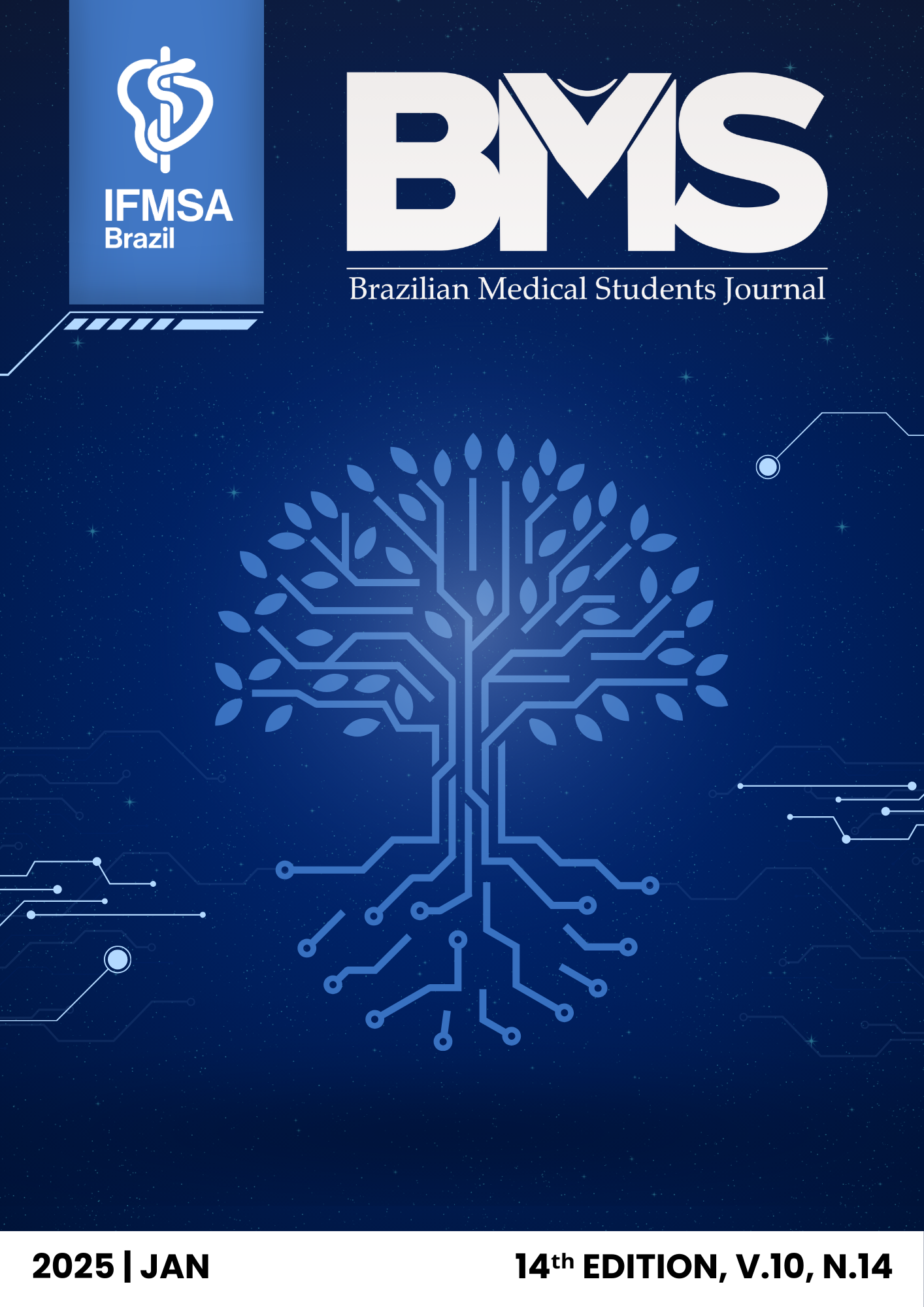Antidepressant and ASD – systematic review
DOI:
https://doi.org/10.53843/f8ahqr12Keywords:
Antidepressants, Autism Spectrum Disorder, Pregnant WomenAbstract
INTRODUCTION: ASD is a neurodevelopmental disorder with social and communication deficits and stereotypes. External factors in ASD have been questioned. This systematic review analyzed studies up to October 2023 on prenatal AD and the onset of ASD. METHODS: The databases used were PubMed, Cochrane and VHL. RESULTS: Seven articles met the selected criteria: AD use, prenatal period, symptoms and diagnosis in the offspring, five were in humans and two in animals. This is a significant number of patients. There is disagreement in the results, most of which rule out the relationship. Brennan, 2022 points out that it does exist. They found more depressive offspring, ADHD and a correlation with the 16p11.2 deletion. The animal studies describe anxiety.DISCUSSION: Animal studies show behavioral changes characteristic of ASD (rejection of social interaction and repetitive behaviors). Human studies agree that there are higher rates of ASD diagnosis in the children of women with psychiatric disorders, especially major depression. Individual studies have revealed high symptom scores in children exposed to SSRIs in the womb and the use of SSRIs with higher rates of ADHD.CONCLUSION: There is an association with an increased risk of cognitive and emotional disorders. There is disagreement as to the affirmation of this relationship, but it is found. Further studies are recommended.
Keywords (Palavras-chave em Inglês): Antidepressants; Autism Spectrum Disorder; Pregnant Women.
References
1. –Clements CC, Castro VM, Blumenthal SR, Rosenfield HR, Murphy SN, Fava M, et al. Prenatal antidepressant exposure
is associated with risk for attention-deficit hyperactivity disorder but not autism spectrum disorder in a large health system.
Mol Psychiatry. 2015 Jun 26;20(6):727–34. doi: 10.1038/mp.2014.90.
2. Brennan PA, Dunlop AL, Croen LA, Avalos LA, Salisbury AL, Hipwell AE, et al. Prenatal antidepressant exposures and
autism spectrum disorder or traits: a retrospective, multi-cohort study. Res Child Adolesc Psychopathol. 2022 Apr 1. doi:
10.1007/s10802-022-01000-5.
3. Ackerman S, Schoenbrun S, Hudac C, Bernier R. Interactive effects of prenatal antidepressant exposure and likely gene
disrupting mutations on the severity of autism spectrum disorder. J Autism Dev Disord. 2017 Aug 2;47(11):3489–96. doi:
10.1007/s10803-017-3246-6.
4. Malm H, Brown AS, Gissler M, Gyllenberg D, Hinkka-Yli-Salomäki S, McKeague IW, et al. Gestational exposure to
selective serotonin reuptake inhibitors and offspring psychiatric disorders: a national register-based study. J Am Acad
Child Adolesc Psychiatry. 2016 May;55(5):359–66. doi: 10.1016/j.jaac.2016.02.013.
5. Lawrence RH, Palumbo MC, Freeman SM, Guoynes CD, Bales KL. Developmental fluoxetine exposure alters behavior
and neuropeptide receptors in the prairie vole. Front Behav Neurosci. 2020 Nov 16;14:584731. doi:
10.3389/fhbeh.2020.584731.
6. Qiu W, Go KA, Wen Y, Duarte-Guterman P, Eid RS, Galea LAM. Maternal fluoxetine reduces hippocampal inflammation
and neurogenesis in adult offspring with sex-specific effects of periadolescent oxytocin. Brain Behav Immun. 2021
Oct;97:394–409. doi: 10.1016/j.bbi.2021.06.012.
7. Slawson D. No increased risk of ASD, ADHD, or SGA with first-trimester antidepressant use: clinical question. Am Fam
Physician. 2017;96. Available from: http://www.essentialevidenceplus.com/product/ebm_loe.cfm?show=oxford.
8. Mitchell AA, Gilboa SM, Werler MM, Kelley KE, Louik C, Hernández-Díaz S. Medication use during pregnancy, with
particular focus on prescription drugs: 1976-2008. Am J Obstet Gynecol. 2011 Jul;205(1):51.e1–8. doi:
10.1016/j.ajog.2011.02.029.
9. Iossifov I, O’Roak BJ, Sanders SJ, Ronemus M, Krumm N, Levy D, et al. The contribution of de novo coding mutations
to autism spectrum disorder. Nature. 2014 Nov 1;515(7526):216–21. Available from:
https://www.nature.com/articles/nature13908/. doi: 10.1038/nature13908.
10. American Psychiatric Association (APA). Diagnostic and statistical manual of mental disorders: DSM-5. 5th ed. Porto
Alegre: Artmed; 2014.
11. PRISMA. PRISMA flow diagram [Internet]. 2020. Available from: http://www.prismastatement.org/PRISMAStatement/FlowDiagram.
12. Cochrane. RoB 2: A revised Cochrane risk-of-bias tool for randomized trials [Internet]. 2019. Available from:
https://methods.cochrane.org/bias/resources/rob-2-revised-cochrane-risk-bias-tool-randomized-trials.
13. ROBINS-I tool | Cochrane Methods [Internet]. Available from: https://methods.cochrane.org/robins-i.
14. Molenaar NM, Lambregtse-van den Berg MP, Bonsel GJ. Dispensing patterns of selective serotonin reuptake inhibitors
before, during and after pregnancy: a 16-year population-based cohort study from the Netherlands. Arch Womens Ment
Health. 2019 Feb 14;23(1):71–9.
15. Sato A, Kotajima-Murakami H, Tanaka M, Katoh Y, Ikeda K. Influence of prenatal drug exposure, maternal inflammation,
and parental aging on the development of autism spectrum disorder. Front Psychiatry. 2022 Feb 9;13:830408.
16. Castelbaum L, Sylvester CM, Zhang YI, Yu Q, Constantino JN. On the nature of monozygotic twin concordance and
discordance for autistic trait severity: a quantitative analysis. Behav Genet. 2020;50(4):263–72.
17. Von Ehrenstein OS, Cui X, Yan Q, Aralis H, Ritz B. Maternal prenatal smoking and autism spectrum disorder in offspring:
a California statewide cohort and sibling study. Am J Epidemiol. 2021;190(5):728–37.
18. Smearman EL, Hendrix CL, Winiarski DA, Johnson KC, Smith AK, Ousley OY, et al. School-age social behavior and
pragmatic language ability in children with prenatal serotonin reuptake inhibitor exposure. Dev Psychopathol. 2020 Feb
1;32(1):21–30.
19. Uguz F. Maternal antidepressant use during pregnancy and the risk of attention-deficit/hyperactivity disorder in children.
J Clin Psychopharmacol. 2018 Jun;38(3):254–9.
Downloads
Published
Issue
Section
License
Copyright (c) 2025 Maria Fernanda Quandt Treml, Nicole Caroline Junglos, Felipe Silva Luciano Carvalho, Heloisa Bernardi Hummel, Agleicia Ott, Ana Carolina Moreira de Moraes Lima, Débora Delwing Del Magro

This work is licensed under a Creative Commons Attribution 4.0 International License.
User licenses define how readers and the general public can use the article without needing other permissions. The Creative Commons public licenses provide a standard set of terms and conditions that creators and other rights holders can use to share original works of authorship and other material subjects to copyright and certain other rights specified in the public license available at https:// creativecommons.org/licenses/by/4.0/deed.pt_BR. Using the 4.0 International Public License, Brazilian Medical Students (BMS) grants the public permission to use published material under specified terms and conditions agreed to by the journal. By exercising the licensed rights, authors accept and agree to abide by the terms and conditions of the Creative Commons Attribution 4.0 International Public License.






